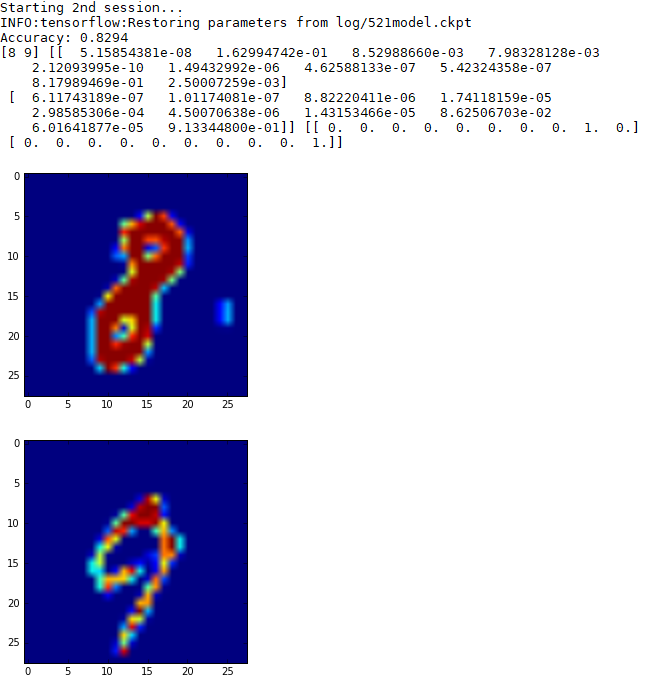识别图中模糊手写数字
本文共 5140 字,大约阅读时间需要 17 分钟。
一 实例
识别图中模糊手写数字
二 代码
import tensorflow as tf #导入tensorflow库from tensorflow.examples.tutorials.mnist import input_datamnist = input_data.read_data_sets("MNIST_data/", one_hot=True)import pylabtf.reset_default_graph()# tf Graph Input'''由于输入图片是个55000X784的矩阵,所所以先创建一个[None, 784]的占位符x和一个[None, 10]的占位符y然后使用feed机制将图片和标签输入进去下面两行代码中的None,表示此张量的第一维度可以是任何长度的。x就代表能够输入任意数量的MNIST图像,每一张图展平成784维的向量。'''x = tf.placeholder(tf.float32, [None, 784]) # mnist data维度 28*28=784y = tf.placeholder(tf.float32, [None, 10]) # 0-9 数字=> 10 classes'''模型也需要权重值和偏执量,它们被统一叫做学习参数。在TensorFlow里,使用Variable来定义学习参数。一个Variable代表一个可修改的张量,定义在TensorFlow的图中,其本身也是一种变量。使用Variable定义的学习参数可以用于计算输入值,也可以在计算中被修改。这里赋予tf.Variable不同的初值来创建不同的参数。一般将W设为一个随机值,将b设为0.'''# Set model weightsW = tf.Variable(tf.random_normal([784, 10]))b = tf.Variable(tf.zeros([10]))# 构建模型'''首先,用tf.matmul(x, W)表示x乘以W,这里x是一个二维张量,拥有多个输入。然后再加上b,把它们的和输入到softmax函数里。至此就构建好了正向传播的结构。也就是表面,只要模型中的参数合适,通过具体的数据输入,就能得到我们想要的分类。'''pred = tf.nn.softmax(tf.matmul(x, W) + b) # Softmax分类'''定义一个反向传播的结构,编译训练模型,以得到合适的参数。下面这段代码这样理解1 将生成的pred与样本标签y进行一次交叉熵的运算,然后取平均值。2 将这个结果作为一次正向传播的误差,通过梯度下降的优化方法找到能够使这个误差最小化的b和W的偏移量。3 更新b和W,使其调整为合适的参数。整个过程就是不断让损失值(误差值cost)变小。因为损失值越小,才能表明输出的结果跟标签数据越相近。当cost小到我们需求时,这时的b和W就是训练出来的合适值。'''# Minimize error using cross entropy,损失函数cost = tf.reduce_mean(-tf.reduce_sum(y*tf.log(pred), reduction_indices=1))#参数设置'''这里涉及一个"学习率"的概念。学习率,是指每次改变学习参数的大小。'''learning_rate = 0.01# 使用梯度下降优化器optimizer = tf.train.GradientDescentOptimizer(learning_rate).minimize(cost)'''training_epochs代表要把整个训练样本集迭代25次batch_size代表在训练过程中一次取100条数据进行训练display_step每训练一次把具体中间状态显示出来。session中有两个run,第一个run是运行初始化,第二个run是运行具体的运算模型。模型之后便是里面的状态。'''training_epochs = 25batch_size = 100display_step = 1saver = tf.train.Saver()model_path = "log/521model.ckpt"# 启动sessionwith tf.Session() as sess: sess.run(tf.global_variables_initializer())# Initializing OP # 启动循环开始训练 for epoch in range(training_epochs): avg_cost = 0. total_batch = int(mnist.train.num_examples/batch_size) # 遍历全部数据集 for i in range(total_batch): batch_xs, batch_ys = mnist.train.next_batch(batch_size) # Run optimization op (backprop) and cost op (to get loss value) _, c = sess.run([optimizer, cost], feed_dict={x: batch_xs, y: batch_ys}) # Compute average loss avg_cost += c / total_batch # 显示训练中的详细信息 if (epoch+1) % display_step == 0: print ("Epoch:", '%04d' % (epoch+1), "cost=", "{:.9f}".format(avg_cost)) print( " Finished!") # 测试 model correct_prediction = tf.equal(tf.argmax(pred, 1), tf.argmax(y, 1)) # 计算准确率'''测试错误率的算法是:直接判断预测的结果与真实的标签是否相同,如果相同的就表示是正确的,如果不相同就表示是错误的。然后将正确的个数除以总个数,得到的值即为正确率。由于onehot编码,这里使用了tf.argmax函数返回onehot编码中数值为1元素下标。测试正确率的算法与损失值的算法略有不同,但代表的意义却很类似。当然,也可以直接拿损失值的交叉熵结果来代表模型测试的错误率。''' accuracy = tf.reduce_mean(tf.cast(correct_prediction, tf.float32)) print ("Accuracy:", accuracy.eval({x: mnist.test.images, y: mnist.test.labels})) # Save model weights to disk save_path = saver.save(sess, model_path) print("Model saved in file: %s" % save_path)#读取模型'''读取模型并将两张图片放进去让模型预测结果,然后将两张图及其对应的标签一并显示出来。'''print("Starting 2nd session...")with tf.Session() as sess: # Initialize variables sess.run(tf.global_variables_initializer()) # Restore model weights from previously saved model saver.restore(sess, model_path) # 测试 model correct_prediction = tf.equal(tf.argmax(pred, 1), tf.argmax(y, 1)) # 计算准确率 accuracy = tf.reduce_mean(tf.cast(correct_prediction, tf.float32)) print ("Accuracy:", accuracy.eval({x: mnist.test.images, y: mnist.test.labels})) output = tf.argmax(pred, 1) batch_xs, batch_ys = mnist.train.next_batch(2) outputval,predv = sess.run([output,pred], feed_dict={x: batch_xs}) print(outputval,predv,batch_ys) im = batch_xs[0] im = im.reshape(-1,28) pylab.imshow(im) pylab.show() im = batch_xs[1] im = im.reshape(-1,28) pylab.imshow(im) 三 运行结果
Extracting MNIST_data/train-images-idx3-ubyte.gz
Extracting MNIST_data/train-labels-idx1-ubyte.gz
Extracting MNIST_data/t10k-images-idx3-ubyte.gz
Extracting MNIST_data/t10k-labels-idx1-ubyte.gz
Epoch: 0001 cost= 7.858615231
Epoch: 0002 cost= 4.281104081
Epoch: 0003 cost= 2.983453018
Epoch: 0004 cost= 2.376332026
Epoch: 0005 cost= 2.032362357
Epoch: 0006 cost= 1.808627782
Epoch: 0007 cost= 1.649085030
Epoch: 0008 cost= 1.528221663
Epoch: 0009 cost= 1.432857099
Epoch: 0010 cost= 1.354939125
Epoch: 0011 cost= 1.289974567
Epoch: 0012 cost= 1.234893327
Epoch: 0013 cost= 1.187199105
Epoch: 0014 cost= 1.145635491
Epoch: 0015 cost= 1.108765103
Epoch: 0016 cost= 1.075907613
Epoch: 0017 cost= 1.046485638
Epoch: 0018 cost= 1.019601378
Epoch: 0019 cost= 0.995143512
Epoch: 0020 cost= 0.972762282
Epoch: 0021 cost= 0.952079509
Epoch: 0022 cost= 0.932801402
Epoch: 0023 cost= 0.915190343
Epoch: 0024 cost= 0.898526331
Epoch: 0025 cost= 0.882988903
Finished!
Accuracy: 0.8294
Model saved in file: log/521model.ckpt

四 说明
第一个数组是输出的预测结果。
第二个大的数组比较大,是预测出来的真实输出值。
第三个大的数组都是0和1,是标签值onehot编码,表示8和9.
注意:这里恰巧举了一个全部正确的例子,因为还有0.18的错误率,所有有时也会预测错误。
你可能感兴趣的文章
mysql驱动、durid、mybatis之间的关系
查看>>
mysql驱动支持中文_mysql 驱动包-Go语言中文社区
查看>>
MySQL高可用之——keepalived+互为主从
查看>>
MySQL高可用切换_(5.9)mysql高可用系列——正常主从切换测试
查看>>
MySQL高可用解决方案
查看>>
MySQL高可用解决方案详解
查看>>
MYSQL高可用集群MHA架构
查看>>
MySQL高可用集群架构MHA企业级实战
查看>>
MySQL高级-MySQL存储引擎
查看>>
MySQL高级-MySQL并发参数调整
查看>>
MySQL高级-MySQL应用优化
查看>>
MySQL高级-MySQL查询缓存优化
查看>>
MySQL高级-MySQL锁
查看>>
MySQL高级-SQL优化
查看>>
MySQL高级-SQL优化步骤
查看>>
MySQL高级-内存管理及优化
查看>>
MySQL高级-存储过程和函数
查看>>
MySQL高级-索引
查看>>
MySQL高级-索引的使用及优化
查看>>
MySQL高级-视图
查看>>